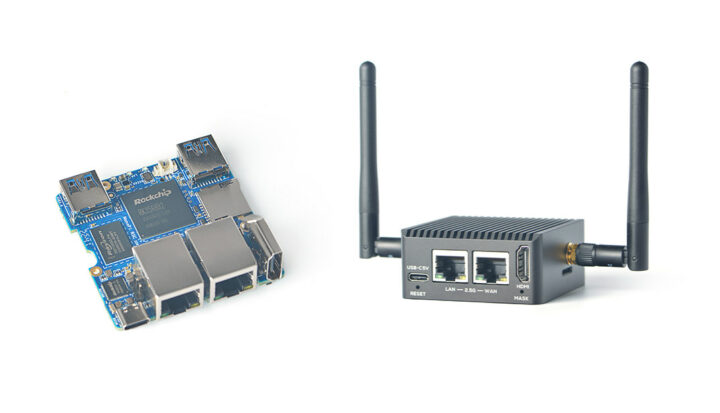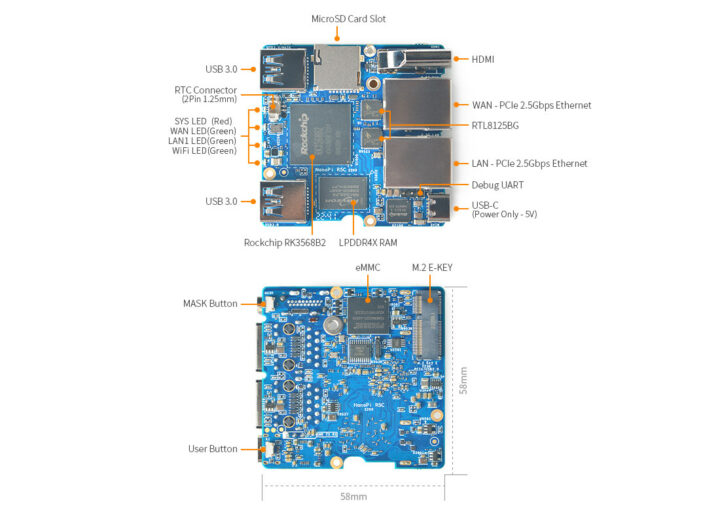FriendlyElec NanoPi R5C is a smaller version of the NanoPi R5S router with the same Rockchip RK3568 processor, but only two 2.5GbE ports and support for an internal M.2 WiFi and Bluetooth module, instead of just USB dongles for the earlier NanoPi R-series routers.
The mini router can also be used as a mini PC thanks to a built-in HDMI 2.0 video output port and two USB 3.2 ports and is offered in two versions with either 1GB RAM and 8GB eMMC flash, or 4GB RAM and 32GB storage for just $10 more.
NanoPi R5C specifications:
- SoC – Rockchip RK3568B2 quad-core Cortex-A55 processor @ up to 2.0 GHz with Arm Mali-G52 MP2 GPU, 0.8 TOPS AI accelerator, 4Kp60 H.265/H.264/VP9 video decoder, 1080p60 H.264/H.265 video encoder
- System Memory & Storage
- 1GB LPDDR4X and 8GB eMMC flash or 4GB LPDDR4X and 32GB eMMC flash
- MicroSD card socket
- Video Output – 1x HDMI 2.0 port up to 4Kp60
- Networking
- 2x 2.5GbE RJ45 ports (via 2x Realtek RTL8125BG PCIe controller) tested up to 2.30 Gbps (Rx) and 2.10 Gbps (Tx)
- WiFi and Bluetooth via M.2 Key E module (PCIe 2.1 x1 + 1x USB 2.0). Tested with RTL8822CE WiFi 5 and Bluetooth 5.0 module up to 276 Mbps (Rx) and 156 Mbps (Tx)
- USB – 2x USB 3.2 Gen 1 ports
- Debugging – 3-pin UART header
- Misc – Mask key for eMMC flash update, user button, 2-pin connector for RTC, 4x user LEDs
- Power Supply – 5V via USB Type-C
- Dimensions – PCB: 58 x 58 mm; enclosure: 62.5 x 62.5 x 29 mm
- Weight – 38 grams without the case, 170 grams with the metal enclosure and antennas
- Temperature Range – 0 to 70
Besides one lost Gigabit Ethernet port, the NanoPi R5C also does without the M.2 socket for NVMe SSD found in NanoPi R5S since the company makes use of the PCIe interface for wireless modules instead. All GPIO connectors are gone as well, and the board only supports 5V input, while its big brother would take USB PD adapters up to 12V.
FriendlyELEC provides several Linux images for the board/router, namely FriendlyWrt 22.03 64-bit based on the latest OpenWrt 22.03, Debian Buster Desktop, and FriendlyCore Lite based on Ubuntu 20.04 with all images relying on the Linux 5.10 LTS kernel. The company also supports buildroot for people wanting to roll out their own custom Linux distribution. More details can be found in the Wiki.
The NanoPi R5C router is sold on FriendlyElec’s store for $49 with 1GB RAM and 8GB storage, and $59 for the 4GB/32GB model, both shipping with the metal enclosure. The RTL8822CE WiFi and Bluetooth module (and antennas?) add $18 to the total. The company does not appear to sell the SBC separately.
Via Liliputing

Jean-Luc started CNX Software in 2010 as a part-time endeavor, before quitting his job as a software engineering manager, and starting to write daily news, and reviews full time later in 2011.
Support CNX Software! Donate via cryptocurrencies, become a Patron on Patreon, or purchase goods on Amazon or Aliexpress






